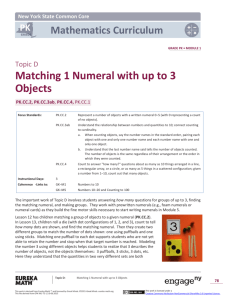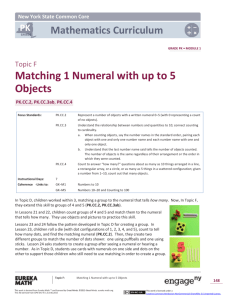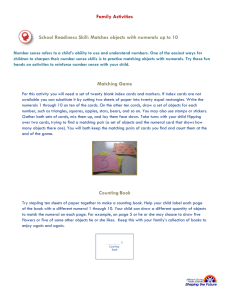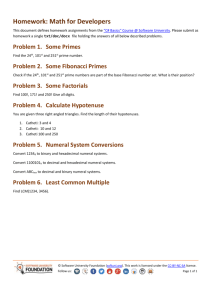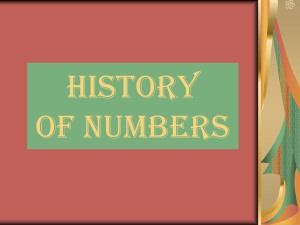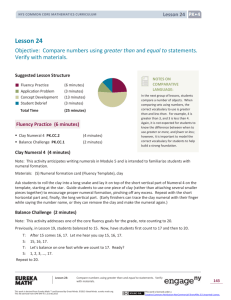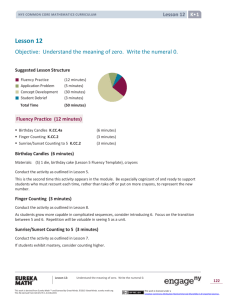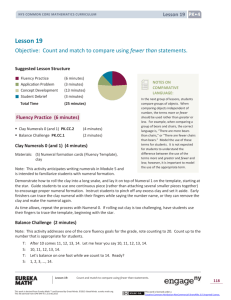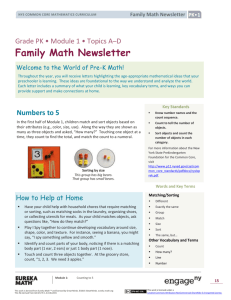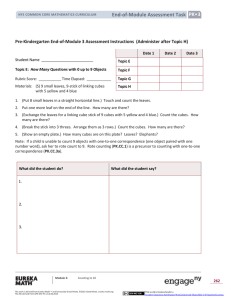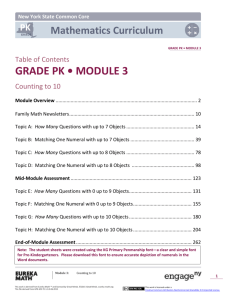Prekindergarten Mathematics, Module 1, Topic D
advertisement
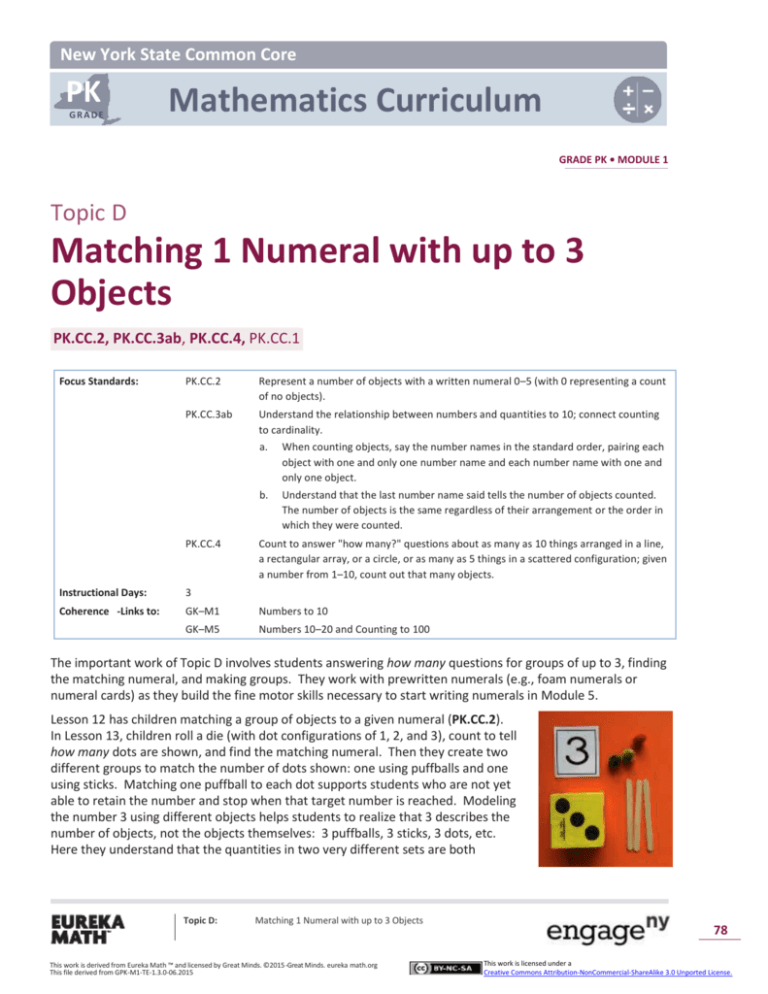
New York State Common Core PK GRADE Mathematics Curriculum GRADE PK • MODULE 1 Topic D Matching 1 Numeral with up to 3 Objects PK.CC.2, PK.CC.3ab, PK.CC.4, PK.CC.1 Focus Standards: PK.CC.2 Represent a number of objects with a written numeral 0–5 (with 0 representing a count of no objects). PK.CC.3ab Understand the relationship between numbers and quantities to 10; connect counting to cardinality. PK.CC.4 a. When counting objects, say the number names in the standard order, pairing each object with one and only one number name and each number name with one and only one object. b. Understand that the last number name said tells the number of objects counted. The number of objects is the same regardless of their arrangement or the order in which they were counted. Count to answer "how many?" questions about as many as 10 things arranged in a line, a rectangular array, or a circle, or as many as 5 things in a scattered configuration; given a number from 1–10, count out that many objects. Instructional Days: 3 Coherence -Links to: GK–M1 Numbers to 10 GK–M5 Numbers 10–20 and Counting to 100 The important work of Topic D involves students answering how many questions for groups of up to 3, finding the matching numeral, and making groups. They work with prewritten numerals (e.g., foam numerals or numeral cards) as they build the fine motor skills necessary to start writing numerals in Module 5. Lesson 12 has children matching a group of objects to a given numeral (PK.CC.2). In Lesson 13, children roll a die (with dot configurations of 1, 2, and 3), count to tell how many dots are shown, and find the matching numeral. Then they create two different groups to match the number of dots shown: one using puffballs and one using sticks. Matching one puffball to each dot supports students who are not yet able to retain the number and stop when that target number is reached. Modeling the number 3 using different objects helps students to realize that 3 describes the number of objects, not the objects themselves: 3 puffballs, 3 sticks, 3 dots, etc. Here they understand that the quantities in two very different sets are both Topic D: Matching 1 Numeral with up to 3 Objects This work is derived from Eureka Math ™ and licensed by Great Minds. ©2015 -Great Minds. eureka math.org This file derived from GPK-M1-TE-1.3.0-06.2015 78 This work is licensed under a Creative Commons Attribution-NonCommercial-ShareAlike 3.0 Unported License. NYS COMMON CORE MATHEMATICS CURRICULUM Topic D PK 1 represented by the number 3. Topic D: Matching 1 Numeral with up to 3 Objects This work is derived from Eureka Math ™ and licensed by Great Minds. ©2015 -Great Minds. eureka math.org This file derived from GPK-M1-TE-1.3.0-06.2015 79 This work is licensed under a Creative Commons Attribution-NonCommercial-ShareAlike 3.0 Unported License. Topic D PK 1 NYS COMMON CORE MATHEMATICS CURRICULUM In Lesson 13, the dots on the face of the die provided a visual cue for students and allowed them to make groups using one-to-one matching. In Lesson 14, the visual cue is removed as students are asked to show a group of up to 3 cubes. Following up on this, students are then shown the numeral 2 and asked to show that many cubes. Using cards with numerals on one side and dots on the other provides support for children who still need to match to create a group of 1–3 objects. Children need a solid understanding of all four parts of the number core (cardinality, number word list, one-to-one correspondence, and written number symbols) to reach this step. Topic D fluency activities introduce rote counting to 5, which prepares children to work with quantities of 4 and 5 in the upcoming topics. Fluency activities continue to provide practice counting and subitizing 3. The Mid-Module Assessment is administered after Topic D. A Teaching Sequence Toward Mastery of Matching 1 Numeral with up to 3 Objects Objective 1: Match the numerals 1, 2, and 3 to quantities. (Lesson 12) Objective 2: Make a group of up to 3 objects and match the numeral (concrete to abstract). (Lesson 13) Objective 3: Look at a numeral and count out a group of objects to match (abstract to concrete). (Lesson 14) Topic D: Matching 1 Numeral with up to 3 Objects This work is derived from Eureka Math ™ and licensed by Great Minds. ©2015 -Great Minds. eureka math.org This file derived from GPK-M1-TE-1.3.0-06.2015 80 This work is licensed under a Creative Commons Attribution-NonCommercial-ShareAlike 3.0 Unported License.
